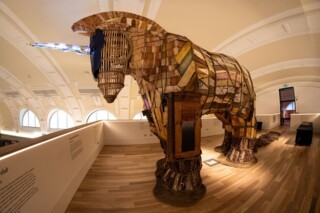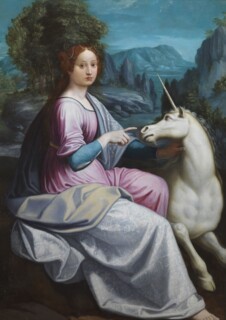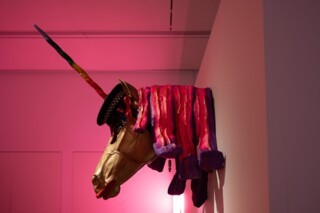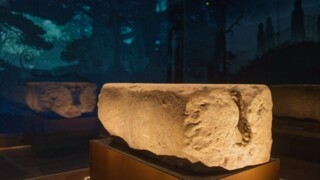The Stone and the Unicorn
Sally Davies
The first person to grasp the marketing potential of the unicorn seems to have been King James I of Scotland. Kidnapped by the English as an 11-year-old in 1406, he wasn’t released for eighteen years. When he assumed the throne, he placed a pair of rampant unicorns on his new coat of arms. The unicorn is still a symbol for Scotland, always depicted in chains – a nod to the years James spent as a hostage, perhaps, or else to the creature’s ferocity, only tamed in the presence of a virgin. But how did it become a byword for billion-dollar start-ups, a mascot for the LGBTQI+ community and the ne plus ultra for pre-teen girls the world over? Like the idea of ‘girlhood’, the unicorn is both pure and sexualised. It’s straight and queer, ubiquitous and unique, ethereal and banal. It’s a paradox, and perhaps that’s why it’s bankable. The unicorn speaks to the contradiction of self-fashioning in the 21st century, when we’re all meant to be buying our way into some kind of singular, self-expressive identity.
The life, death and late capitalist rebirth of the unicorn was the subject of an inaugural exhibition at the Perth Museum, which opened recently after a £27 million renovation of the old town hall. A major reason for the relaunch was to find a new home for the so-called Stone of Destiny – the 152 kg chunk of sandstone on which ancient Scottish kings sat to be crowned, before it was stolen by the English in the 13th century. A new show, Waters Rising, which examines the climate crisis against the backdrop of global histories of flooding, opens on 8 November.
The earliest surviving account of unicorns is from the fourth century BC, when a Greek doctor, Ctesias of Cnidus, wrote down the tales he heard from wayfarers passing through the court of the Persian king. He describes ‘wild asses’ from India with a single white, black and red horn, protruding a foot and a half from their head. Ground into powder and dissolved, the horn would protect anyone who drank it from poisons, convulsions and epilepsy. Ctesias’ narrative was picked up by Aristotle and Pliny the Elder. Much later, Marco Polo claimed to have seen unicorns for himself in Sumatra – creatures as large as an elephant, with hair like a buffalo, a tongue covered in prickles, the head of a boar and a thick, black horn, always pointing towards the ground.
These accounts were probably fanciful descriptions of various species of rhinoceros. Although he never saw one, Albrecht Dürer’s etching of a rhino from 1516 was the canonical rendering in Europe until the 18th century. His nightmarish print of a unicorn was also on display in Perth: a Zeus-like figure is kidnapping a terrified naked woman, their limbs entangled, bestride a creature with bared teeth, rolling eyes and a scimitar-shaped horn. The subject seems mythological, but Dürer may well have believed in the possibility of unicorns, along with many of his contemporaries. In an etching by Jacobus Harrewijn, a more graceful unicorn flanks a hoopoe, a bird that the artist would probably have known by sight.
The ‘unicorn horns’ that wealthy Europeans collected for their cabinets of curiosities were narwhal tusks, hunted by European seafarers or obtained through trade with the Inuit of Greenland and Canada. The Danny Jewel, fashioned around 1550, is a cross-section of a white horn in the shape of a ship, set in gold with an enamelled boss, suspended by three delicate chains. Its reverse side shows signs of being scraped: perhaps the powder was sprinkled in water and drunk for its purifying and curative properties. Over time, such curiosities came to be seen less as signs of God’s mysterious handiwork than as exceptions to the general rules emerging from early scientific discourse.
The unicorn gets no mention in the Hebrew Bible. But re'em – a horned creature, perhaps the extinct aurochs – appeared in the Greek Septuagint as μονόκερως (‘one-horned’) and in the Latin Vulgate as unicornis. In the Middle Ages, the myth of unicorns and virgins was interpreted as an allegory for Jesus and Mary, and unicorns can be found cavorting across illuminated manuscripts and bestiaries. A beautifully preserved Flemish tapestry, woven of wool and silk in 1550, deploys the Christian motif of the hortus conclusus – a walled garden bursting with flowers, a symbol of Mary’s womb, with a solitary unicorn at the centre figuring as the godchild within it.
Renaissance painters moved away from the unicorn as a religious icon and instead toyed with the phallic allegorical potential of its horn in depictions of chastity. A full-length portrait by Luca Longhi, produced between 1535 and 1540, shows a person believed to be Giulia Farnese, lover of pope Alexander VI. She is resting on a riverbank, draped in dusty pinks and pale blues, a unicorn at her side. She presses her thumb against the creature’s jugular, and it submits to her control, while the finger of her free hand points to its muzzle. There’s a gestural boldness to the composition, as if Farnese is daring us to repeat the rumours we might have heard, and to defy this evidence of her purity.
Tucked away in a side-gallery were two elaborately pimped-up denim jackets, covered with rainbows and unicorns and post-punk embroidery. Celebratory, self-aware and defiant, they were the fruit of a collaboration between young queer people in Perth, Scotland, and Perth, Western Australia. On the back of one was a beach scene with the slogan: ‘Have a Gaytime in Golden Perth, WA’.
As it happens, that’s where I grew up. I remember friends playing with My Little Ponies, a franchise that was an accidental ally in the unicorn’s coming out. It exploded in popularity in the 1980s, around the same time that Lisa Frank’s technicolour unicorn designs started galloping across school supplies throughout the United States and beyond. All this cemented an association between rainbows and unicorns, which dovetailed with the gay community’s rainbow flag designed in the previous decade by Gilbert Baker.
The Perth Museum had also commissioned six LGBTQIA+ artists to transform a life-sized horse’s head, produced by Ottmar Hörl, into a unicorn. My daughter was transfixed by a drag police unicorn set above a cartoon doppelganger in a high-vis vest, dancing to a remix of Suella Braverman’s words when she was home secretary: ‘We pay the police to fight crime. We do not pay them to wave flags at parades, to dance with drag queens.’ My favourite, though, was a version by Ciaran Cannon, a kind of readymade that hinted at how we might piece together our identity from what’s strewn about us. Painted to resemble weathered metal, the cheek had been cut away, and inside the head was a tangle of screws, nails and a single key. A hoof and foreleg stepped forward out of the wall, as if denying the solidity of the plaster, and of gender along with it.
The final room was dominated by a giant wooden unicorn, Destiny, designed by Becky Minto and made by Scott Bisset from reclaimed timber, with lighting design by Kate Bonney. When you walked inside it, you discovered everyday objects – rainbow shirts, trail shoes from a queer running club – that the museum has collected from LGBTQIA+ groups in and around Perth. At one level, Destiny skewers transphobic stories propagated by the right-wing press, with unfounded claims about ‘Trojan horses’. The jumble of objects inside also hints at those cabinets of wonder. But the real force of the piece came from the contrast in scale between the towering exterior and the mundane, material traces of human work suspended inside.
Many of the objects in the Perth Museum’s permanent collection – one of the oldest in the UK – were acquired by the city’s 18th-century Literary and Antiquarian Society. A 4000-year-old longboat in the main hall, preserved in the mud of the River Tay, was carved from an oak tree that was four hundred years old at the time it was cut down. A ten-kilo fragment of meteorite that fell to earth in December 1917, the largest ever recorded in Scotland, sits next to a microscope used by Charles McIntosh, the naturalist and friend of Beatrix Potter. There are Pictish standing stones, a child’s shoe preserved from the time of Highland Clearances, suffragette banners and a striking Māori cloak (kahu huruhuru). Brought to Scotland by a ship’s surgeon in the early 19th century, and now restored in consultation with Māori elders, its outer layer is fashioned from feathers of the kākāpō, a rare flightless parrot of which there were only two hundred or so remaining at the last count.
As for the Stone of Destiny, it’s housed in a tall wooden tabernacle in the main hall. Fifteen visitors at a time are fed through like plates on a sushi train, after being primed with a brisk educational film about the stone’s history. When you’re finally given a few moments in the presence of the stone, your eyes may wander to the video projection on the walls, which along with a soundtrack of chimes and bird trills purports to immerse you in an open-air crowning ceremony for a Celtic king.
This guided passage ‘experience’ probably has as much to do with security as anything. Last year at Edinburgh Castle, where the stone had been housed since 1996, activists from the climate and anti-poverty group This Is Rigged spraypainted ‘Is treasa tuath na tighearna’ (‘The people are mightier than a lord’) on the plexiglass case in protest at the Scottish government’s approach to food poverty.
There are various legends about the stone’s origins – one even claims that it was the stone Jacob took for a pillow when he dreamed of a ladder to heaven. But the evidence suggests it was quarried near Scone Palace, just outside Perth, where 42 Scottish kings were crowned from the ninth century onwards. Then in 1296, the English king Edward I pilfered the stone, took it to Westminster and had a wooden chair made to enclose it, on which British monarchs have been crowned ever since.
The suffragettes bombed the chair in 1914, leaving the stone apparently undamaged – but perhaps weakening an ancient fault-line that came to light when four Glasgow University students broke into Westminster Abbey on Christmas Day in 1950. When they yanked the stone out of the chair by its rusty rings, it fell to the floor and broke in two. They took it to a mason, who cemented it back together, and smuggled it onwards to Scotland. The Met Police recovered it but the students weren’t prosecuted. The stone was eventually repatriated on the agreement that it would be ferried south for coronations, as it was for the first time for Charles III last year.
Official records declassified in January revealed that the late Alex Salmond, the former SNP leader and first minister, was given a shard of the stone by the son of one of the conspirators in the 1950 heist. It was feared lost but turned up in a cupboard at the SNP headquarters. In May, Historic Environment Scotland declared the fragment genuine ‘beyond reasonable doubt’. There have been calls for the chip to be displayed alongside its old block at the Perth Museum – a reminder that enduring myths can have unruly afterlives.



